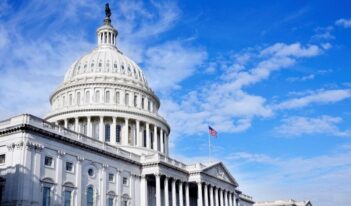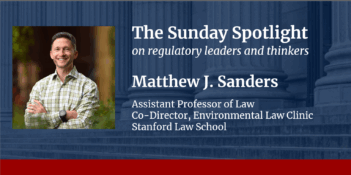
EPA’s advance notice raises fundamental questions about how the agency should weigh costs and benefits.
Recently, the U.S. Environmental Protection Agency (EPA) issued an advance notice of proposed rulemaking (ANPRM) that asks the public to comment on the possible development of regulations for “increasing consistency and transparency in considering costs and benefits in the rulemaking process.” This framing suggests three propositions which I examine in this essay: (1) Costs and benefits should be considered in EPA’s rulemaking process; (2) Consistency and transparency in EPA’s use of cost-benefit analysis should be improved; and (3) EPA requires regulations to implement such improvements.
It is difficult to argue with the first two propositions. Considering positive and negative impacts seems like an essential component of any decision-making process. Consistency and transparency seem like laudable goals too, and improvement is always possible. But what do terms such as “consider,” “consistency,” and “transparency” really mean in this context?
The third proposition—that EPA requires regulations to address these concerns—seems to itself require at least an informal cost-benefit test. EPA is essentially proposing to develop and enforce regulations to govern its own behavior; the resources it expends on this task will not be available for other purposes. Other options include, for example, strengthening or increasing enforcement of EPA’s existing cost-benefit analysis guidelines, providing more time and resources for conducting such analyses, and facilitating better communication of the results.
When considering these three propositions, political motivation is one issue to keep in mind given the deregulatory stance of the current administration. As recognized in the ANPRM, another issue is the relationship of these propositions to the legal constraints under which the agency operates, including statutory authorities and their interpretation by the courts. I instead focus here on how these propositions relate to the practice of cost-benefit analysis and its use in decision-making.
In the ANPRM, EPA appears to separate consideration of analytic practices from consideration of the use of the results, stating that it “is taking comment on the role that regulatory analysis or aspects of that analysis play in decision making,” not on the guidance for conducting the analysis. However, EPA also notes that it is soliciting comment on whether to “prescribe specific analytic approaches.” Regardless of whether the intent is to focus solely on the use of cost-benefit analysis or to also address its conduct, these two topics cannot be easily separated. To be useful, cost-benefit analysis must be well-conducted. Otherwise, reliance on its conclusions may lead to poor decisions.
EPA has long been a leader in the conduct of cost-benefit analysis, developing frameworks, methodological approaches, and guidance that have been adopted by many others both inside and outside of government. For example, EPA’s Guidelines for Preparing Economic Analyses are widely cited and used by scholars as well as analysts in other agencies, and its Benefits Mapping and Analysis Program is often applied to assess the impacts of air pollution polices at the state and local level and internationally. If EPA decides to move forward with the regulations envisioned in the ANPRM, they will inevitably affect other agencies and the practice of cost-benefit analysis more generally.
As a result, each of the three propositions introduced above merits closer examination.
Proposition 1: Costs and benefits should be considered in EPA’s rulemaking process. Over the past 40 years, Republican and Democratic administrations have agreed that costs and benefits should be considered in the rulemaking process, as exemplified by Executive Order 12,866, issued in 1993, and its predecessor, Executive Order 12,291, issued in 1981. This agreement is reflected in the government-wide implementing guidance provided by the Office of Management and Budget (OMB), as well as in EPA guidance and in guidance provided by the U.S. Department of Health and Human Services (HHS) and other federal agencies.
The term “considered” is key. These executive orders and guidance documents reflect broad consensus that the cost-benefit analysis provides important, useful information but should not necessarily determine the regulatory decision.
The rationale for this consensus is in part philosophical and in part pragmatic. Cost-benefit analysis is based on an explicit normative framework with two major components. One is that the individual is the best (or most legitimate) judge of his or her own welfare—hence the monetary value of policy impacts should be determined based on individuals’ willingness to exchange income for the outcomes of concern. The second is that the welfare of a society is equal to the sum of these individual values. The idea is that if those whose welfare is improved can, in principle, compensate those whose welfare is harmed, then the net effect of the policy will be positive—even if such compensation does not occur.
Concerns about this framing seem obvious. Perhaps most significantly, people care about the impacts on others as well as on themselves. This concern is evident in the discussion of distribution in the executive orders that mandate regulatory cost-benefit analysis. President Reagan’s Executive Order 12,291 required that the analysis identify who is likely to “receive the benefits” and to “bear the costs.” Its replacement, Executive Order 12,866, states that net benefits include “distributive impacts” and “equity.” Cost-benefit analysis is conventionally framed as a method for assessing economic efficiency—net benefits to society as a whole. The language in the executive orders extends this framing to encompass analysis of distribution—the allocation of these net benefits across members of society. The inclusion of “equity” also means that the extent to which the distribution is fair or just must be weighed.
Existing guidance on cost-benefit analysis appropriately divides responsibility for these equity considerations across analysts and policymakers. The regulatory analyst’s task is to describe the distribution; policymakers and other stakeholders can then evaluate its equity when participating in the decision-making process. Regulatory analyses do not currently provide comprehensive assessments of distribution, however. Thus, an important first step is to increase the agency’s capacity for conducting these analyses, which requires investing in methodological development and research.
The consensus that cost-benefit analysis should inform rather than determine the decision also reflects practical concerns. As is recognized throughout the guidance documents referenced above as well as in EPA’s ANPRM, analysts may not be able to quantify some important outcomes due to limitations in the scientific research available. For example, it is often difficult to estimate the relationship between chemical exposures and particular health outcomes, particularly for non-carcinogens. In other cases, it may be possible to estimate an effect in physical terms, such as the acres of ecosystem protected, but difficult to estimate the monetary value of that effect. Another example is the challenge of measuring the net impact of a new regulation on employment or competitiveness and the associated changes in welfare. If impacts are not quantified and valued, they will not be included in the calculation of net benefits and will need to be evaluated separately.
EPA discusses these difficulties in detail in its regulatory analyses, which explicitly address the implications of non-quantified effects. These difficulties are also reflected in OMB’s annual reports to Congress. Although cost-benefit analysis is required for economically significant regulations, these reports suggest that comprehensive assessment of both benefits and costs is possible for only a subset of those regulations. Increasing the agency’s ability to quantify regulatory impacts is thus another area where investments in methodological development and research are needed. In the interim, weighing these impacts requires substantial judgment about their potential magnitude and importance for decision-making.
Proposition 2: Consistency and transparency in EPA’s use of cost-benefit analysis should be improved. What does it mean to be consistent? Does it mean that policy decisions should always be made on the same basis? Does it mean that the supporting cost-benefit analysis must also always address the same concerns?
It seems that the answers to the latter two questions must be “no.” Both the basis for the decision and the conduct of the analysis should be tailored to the context. Public policies inevitably raise complex issues, and the relative importance of these issues and how they are weighed in decisions necessarily varies. These differences arise in part because these decisions involve difficult normative issues that require judgment and are not easily resolved through research. For example, how should we weigh policies that impose small costs on many people but significantly benefit a few individuals? How much protection is needed when relatively little is known about a potential hazard or when its effects are highly uncertain? The ANPRM recognizes that variation results in part from the constraints and opportunities provided by the legal system within which these regulations are developed. The basis for the decision will also vary depending on the context of the rulemaking—including the population affected, the characteristics of the risks addressed, and the challenges associated with managing the risks—as well as the data available on its potential impacts.
The cost-benefit analysis also must be tailored to the rulemaking context. Such tailoring is necessitated in part by the underlying normative framework. As noted above, within this framework values are determined by the amount of income the affected individuals would exchange for the outcomes they would likely experience: their willingness to pay or to accept compensation. Consistency with this framework means that the values used in the cost-benefit analysis should vary depending on the preferences of the individuals affected—to the extent available research allows—and adjusted when justified by new research.
The second reason for tailoring the cost-benefit analysis is more pragmatic. Regulatory cost-benefit analyses are usually conducted within tight timeframes with limited staff and other resources. This means that analysts must consider whether the cost of assessing a particular policy option or quantifying a specific outcome will be greater than the likely benefit of assessing it, given its importance for decision-making. Screening analysis that relies on easily accessible data and simple assumptions is an important tool that aids analysts in deciding what to exclude from more detailed assessment and where to focus additional research. It also provides data that can be used to roughly indicate the magnitude of those impacts that are not assessed in detail.
Issues related to such tailoring are exemplified in EPA’s ANPRM, which asks whether uniform definitions should be developed for terms such as “cost,” “benefit,” “economic factors,” “reasonable,” “appropriate,” and “weight of scientific evidence.” Although the terms “cost” and “benefit” have technical economic definitions, even the experts do not entirely agree on how these concepts should be applied. For example, as noted in the HHS guidelines, the categorization of regulatory impacts as “benefits” or “costs” is not necessarily consistent across analyses. The other terms generally require the application of judgment based on the characteristics of the individual rulemaking. For example, what is “appropriate” or “reasonable” is likely to vary and must be clearly defined within the context of each regulation. EPA currently can, and does, define such terms in the preamble to the Federal Register notice that announces each regulation as well as in supporting materials.
Another related issue is addressing what are sometimes referred to as co-benefits or ancillary benefits, as well as what could be referred to as co-costs or ancillary costs. The current guidance on conducting cost-benefit analysis is clear: The analysis involves comparing conditions without the regulation to conditions with it. All impacts should be considered. The fact that regulation often has both costs and benefits beyond those defined or intended by the authorizing statute is important information for decision-makers. Once analyzed, these impacts can be reported in the aggregate as well as in disaggregated form for consideration. Instead, ignoring these effects seems irresponsible—especially if they are significant—given that the overall goal is to enhance societal welfare.
These factors do, however, reinforce the need for transparency. One problem for regulatory analysts is that cost-benefit analyses are detailed and technical. A second is that these analyses and the decisions they support may be substantially revised relatively late in the process, as a result of internal agency and OMB review. Little time is available for developing and updating materials designed to inform the general public. Providing more training and developing more templates or examples for effective communications may help analysts better translate the results for a broader audience. The goal is to ensure that policymakers and other stakeholders understand the analytic approach and the results, and the implications of the results for decision-making, including the effects of uncertainties.
Proposition 3: EPA requires regulations to implement such improvements. EPA has created substantial guidance on the conduct of cost-benefit analysis. It also has mechanisms in place to enforce adherence to this guidance and to determine how to best use the analytic results in its decision-making.
Before a proposed or final regulation is issued, the regulatory analysis and the basis for the regulatory decision are reviewed by EPA’s Office of Policy, which is located within the Office of the EPA Administrator. For significant regulations, the analysis and the decision are also reviewed by OMB, which is located within the Executive Office of the President. Both groups have the ability to compel changes in the analysis and in the regulatory requirements, to address concerns about the use of cost-benefit analysis and its consistency and transparency. The public notice and comment process that is required for proposed regulations provides additional opportunities for EPA to identify problems and explain its reasoning. It is unclear why EPA needs to regulate its use of cost-benefit analysis, given that it already has the power to address the concerns raised in the ANPRM.
Developing new regulations requires significant staff and other resources. Consideration of the challenges noted above suggests EPA may be better served by devoting these resources to investing in methodological and other improvements. Regulating the application of cost-benefit analysis is likely to be controversial and the need for such regulations is questionable.
This essay is part of a series, entitled Consistency and Transparency in Environmental Cost-Benefit Analysis.




